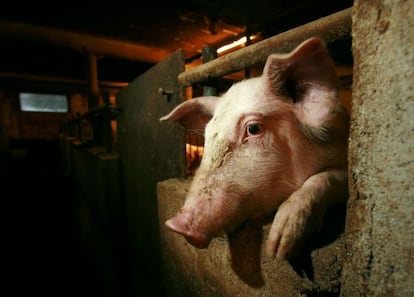Why China is hogging Iberian pork
Spanish exporters of pig products are struggling to keep up with demand from Asian giant


Today the flag of Taiwan is flying over the Faccsa pork factory in Cártama, Málaga province – a courtesy to the latest visitors to this family-run firm. Inside there’s also a framed portrait of Chairman Mao, which is taken down and put back up at the rhythm of the many Asian arrivals and departures. “The demand is tremendous,” explains the company’s deputy general manager, Francisco Requena. “I recently told a Chinese client to take away some samples to see if he liked the product, but he took away 20 containers all in one go. He told me, ‘This is the sample. If I like it, I’ll come by for more.’ The volume they handle is incredible.”
Like Faccsa, a handful of other Spanish pork producers have also found themselves overwhelmed by the demand from the Chinese market, sending pork to the top of the list of Spanish products sold to the Asian giant, above the more traditional exports of wine and oil.
I recently told a Chinese client to take away some samples. He took away 20 containers all in one go” Francisco Requena of pork producer Faccsa
The phenomenon is a relatively new one. And it’s also growing – in China not only are there 1.3 billion mouths to feed with a liking for pork, but also a burgeoning middle class, who before may have only eaten meat once a year, but can now afford it several times a month, or even a week.
To top it all, the Chinese have a particular fondness for cuts that are much less appreciated in Spain: stomach, intestine, ear, thigh bone, head and trotter are all prized delicacies that in Asia pale in comparison to cured ham or pork loin.
Together it creates an economic equation that’s almost perfect for Spanish businessmen, as Javier Serra, the chief economic and trade advisor at the Spanish Embassy in Beijing, explains: “We see tremendous potential. It’s a market that’s growing a lot. There are now around 20 companies authorized [to export]. We are waiting for Beijing to send over veterinarians to expand the list.” The Chinese delegation is scheduled to visit 17 preselected factories this spring, according to industry sources.
Jaime Palafox, international director at the FIAB federation of Spanish food industries, offers an additional explanation. “In China there is a lack of trust in local products, which is why the middle class is interested in imported goods,” he says.
The customs data that Serra handles shows Spain exported €235 million in pork products to China in 2014, representing growth of 40 percent on 2012. Of that amount, around €110 million came from sales of offal. Spain is the world’s third-biggest pork exporter, after the US and Germany, while Anice, the National Association of Meat Industries, notes that China is the principal buyer of Spanish offal. Beyond the obvious profits the pork exports bring in, it’s also important to note that Spain has a significant trade deficit with China, reaching €13.42 billion in 2013.
It is cheaper to send eight containers of ear from Cártama to China than a box of sausage to Ronda, which lies just 80 kilometers away by road
Inside Faccsa’s gigantic deep-freeze warehouse, rows of pallets loaded with ears, brains, cartilage and trotters with Chinese labels sit in temperatures of -21ºC, ready to cross the planet. The well-established shipping links with China make transportation easy and surprisingly economical – it is cheaper to send eight containers of ear from Cártama to China than a box of sausage to Ronda, which lies just 80 kilometers away by road. Since Faccsa and other factories began exporting to China in 2008, their business has undergone a revolution that has turned the pricing of pork into an almost impossible puzzle. Some parts stay in Spain, others go to China, Angola, Canada… the carving up of each pig is an almost infinitely complex operation. Faccsa sells 15 percent of its production in Asia and the growth of the business in recent years has been entirely down to exports. It predicts it will grow five percent this year, thanks to Asia.
The company’s new clientele has led to the hiring of young Zhangming Shi, who serves as a link with China, where he is constantly traveling. “There they appreciate the bone more than the meat,” he explains, adding that they use them for soups, later sucking out the precious marrow with a straw. A kilogram of thigh bone, for instance, sells there for just under a euro, but in Spain it would be thrown out.
The advantages for foreign trade are obvious, but there is also no shortage of risks. According to the sector, the main one is the fear that a health scare at one factory could tarnish the reputation of the whole country’s produce and close off the Chinese market to Spanish pork.
In China there is a lack of trust in local products, which is why the middle class is interested in imported goods” Jaime Palafox of the FIAB food industries federation
Then there is politics. Any breakdown in Spanish-Chinese relations would be fatal for Spanish pork producers. They suffered a scare last year when the Spanish High Court issued an international arrest warrant for former Chinese president Jiang Zemin and ex-prime minister Li Peng on charges of genocide, torture and war crimes in Tibet. The ensuing diplomatic crisis prompted the Popular Party government to push through an express reform of Spain’s universal justice law.
“Our exports to China haven’t stopped growing, but in no case do we want them to reach 50 percent of our production,” says Federico Beltrán, president of Famadesa, another major Málaga pork producer. “It’s not good to put all your eggs in one basket.”
Beltrán’s firm has just invested €5 million in adapting its installations to meet Asian demand, including building a giant deep-freeze warehouse. Here the idea of freezing only what is left over is a thing of the past. A sizeable proportion of the 4,500 pigs slaughtered each day at the firm is specifically destined for the deep freeze. “The market is demanding more and more frozen products. We sell between eight and 10 million kilos a year to China,” notes Beltrán, who doesn’t hide his amazement at the speed and magnitude of the changes his business is undergoing.
Tu suscripción se está usando en otro dispositivo
¿Quieres añadir otro usuario a tu suscripción?
Si continúas leyendo en este dispositivo, no se podrá leer en el otro.
FlechaTu suscripción se está usando en otro dispositivo y solo puedes acceder a EL PAÍS desde un dispositivo a la vez.
Si quieres compartir tu cuenta, cambia tu suscripción a la modalidad Premium, así podrás añadir otro usuario. Cada uno accederá con su propia cuenta de email, lo que os permitirá personalizar vuestra experiencia en EL PAÍS.
En el caso de no saber quién está usando tu cuenta, te recomendamos cambiar tu contraseña aquí.
Si decides continuar compartiendo tu cuenta, este mensaje se mostrará en tu dispositivo y en el de la otra persona que está usando tu cuenta de forma indefinida, afectando a tu experiencia de lectura. Puedes consultar aquí los términos y condiciones de la suscripción digital.







































